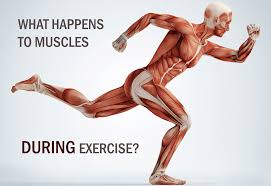
MUSCLES IN EXERCISE
The strength of a muscle is determined mainly by its
size, with a maximal contractile force between 3 and 4 kg/
cm2 of muscle cross-sectional area. Thus, a man who is well
supplied with testosterone or who has enlarged his muscles
through an exercise training program will have correspondingly
increased muscle strength
Muscle Metabolic Systems in Exercise
- Adenosine Triphosphate.
The source of energy actually used to cause muscle contraction is adenosine triphosphate (ATP), which has the following
basic formula:
Adenosine-PO3 ~ PO3 ~ PO3
−
The bonds attaching the last two phosphate radicals to
the molecule, designated by the symbol ~, are high-energy
phosphate bonds. Each of these bonds stores 7300 calories
of energy per mole of ATP under standard conditions (and
even slightly more than this under the physical conditions
in the body.
- Phosphocreatine-Creatine System
Phosphocreatine (also called creatine phosphate) is another
chemical compound that has a high-energy phosphate bond,
with the following formula:
Creatine ~ PO3
This can decompose to creatine and phosphate ion, and in doing so releases large
amounts of energy. In fact, the high-energy phosphate
bond of phosphocreatine has more energy than the bond of
ATP, 10,300 calories per mole compared with 7300 for the
ATP bond. Therefore, phosphocreatine can easily provide
enough energy to reconstitute the high-energy bond of ATP.
Furthermore, most muscle cells have two to four times as
much phosphocreatine as ATP..
- Glycogen-Lactic Acid System
- Aerobic System
Recovery of Muscle Glycogen.
Recovery from exhaustive muscle glycogen depletion is not a simple matter. This often requires days, rather than the seconds, minutes, or hours required for recovery of the phosphagen and lactic acid metabolic systems.on a high-carbohydrate diet, full recovery occurs in about 2 days.
MUSCLE HYPERTROPHY
The changes that occur inside the hypertrophied muscle fibers themselves include (1) increased numbers of myofibrils, proportionate to the degree of hypertrophy; (2) up to120 percent increase in mitochondrial enzymes; (3) as much as 60 to 80 percent increase in the components of the phosphagen metabolic system, including both ATP and phosphocreatine; (4) as much as 50 percent increase in stored glycogen; and (5) as much as 75 to 100 percent increase in stored triglyceride (fat). Because of all these changes, the capabilities of both the anaerobic and the aerobic metabolic systems are increased, increasing especially the maximum oxidation rate and efficiency of the oxidative metabolic system as much as 45 percent.



